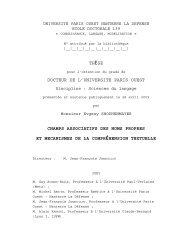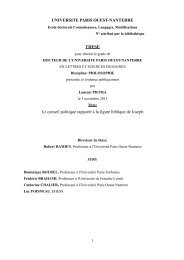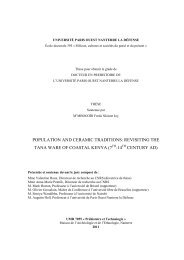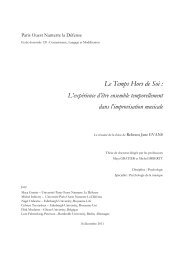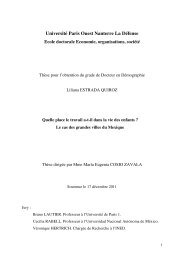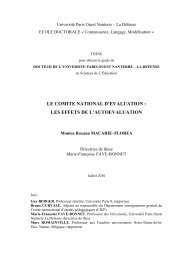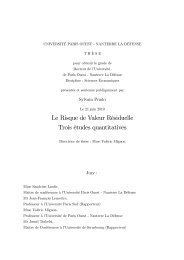Thèse au format PDF - Portail documentaire de l'université de Paris ...
Thèse au format PDF - Portail documentaire de l'université de Paris ...
Thèse au format PDF - Portail documentaire de l'université de Paris ...
Create successful ePaper yourself
Turn your PDF publications into a flip-book with our unique Google optimized e-Paper software.
Abstract<br />
This thesis focuses on the rise of the third party logistics. It does so by proposing answers to<br />
three questions: on which economic mo<strong>de</strong>ls relies the organization of the third party logistic?<br />
Do the firms belonging to the third party logistic share the strategy <strong>de</strong>fined at the group level?<br />
For what reasons logistics and transport activities are outsourced?<br />
The thesis is organized in four chapters. The first chapter presents an historical introduction to<br />
the logistic activities. It focuses on the merchants and the firms that have handled tra<strong>de</strong><br />
through diverse periods from the Roman Empire to the Industrial Revolution. I <strong>de</strong>scribed the<br />
way used to increase the quality and the quantity of in<strong>format</strong>ion available to the merchants.<br />
The second chapter explains the rise of new economic mo<strong>de</strong>ls to organize logistic activities.<br />
The third and fourth chapters present two econometric studies. The third chapter verifies if the<br />
firms belonging to a logistic and transport group comply with the strategy of the group. The<br />
fourth chapter studies the factors that favor the outsourcing of logistics activities.<br />
Tra<strong>de</strong> can be a perilous activity. The first chapter presents an historical study of the different<br />
ways that have reduced the tra<strong>de</strong> uncertainty for the merchants. In particular, I analyze how<br />
the quality and the quantity of in<strong>format</strong>ion available to the merchants have increased through<br />
time. In this aim, I have selected four historical periods: the Roman Empire, three groups of<br />
merchants during the middle age (the Maghribi tra<strong>de</strong>rs of the Fatimid Empire, the Hanseatic<br />
League and the Florentine entrepreneurs), the British Empire and the English East India<br />
Company, and the first Industrial Revolution in the United States of America (USA). For each<br />
of these periods, I have investigated if the manner through which tra<strong>de</strong> was organized by<br />
merchants, the institutions within which the merchants evolved and the technologies at their<br />
disposal helped the <strong>de</strong>velopment of a better in<strong>format</strong>ional environment. This analysis shows<br />
that the highly positive effects of empires on in<strong>format</strong>ion (through the presence of uniform<br />
institutions, the building of roads and markets places) have been slowly replaced by the<br />
organizations and the institutions built at the merchant level once the empires collapsed.<br />
Hierarchies and systems of habits and punishments created within the merchant communities<br />
have permitted to increase the quality of in<strong>format</strong>ion by <strong>de</strong>terring opportunistic behavior. This<br />
chapter also un<strong>de</strong>rlines that the technological innovations of the XIX century in the domain of<br />
in<strong>format</strong>ion coupled to mass production have shifted the focus of the firms from gathering<br />
in<strong>format</strong>ion about where the products are ma<strong>de</strong> and if they were of a homogenous quality to<br />
how to extract in<strong>format</strong>ion about consumers’ <strong>de</strong>sires. This change has highly contributed to<br />
the end of the mercantile companies.<br />
The second chapter consi<strong>de</strong>rs the recent <strong>de</strong>velopment of large international firms in the<br />
logistics and transport industry. My work, in this chapter, is based on a comparison of the<br />
American and French market for logistics and transport activities along the twentieth century.<br />
I have retraced three important periods. The first period, from the end of the First World War<br />
to the seventies, is marked by the growing competition between rail transport and road<br />
h<strong>au</strong>lage, and by the equally growing regulation in the various freight transport activities. The<br />
second period, from the end of the seventies to the middle of the nineties, is a turning point<br />
period for the transport sector; international tra<strong>de</strong> became more liberalized, <strong>de</strong>regulation of<br />
the transport sector occurred, new technologies were diffused, and many shippers adopted just<br />
in time organization. This chapter shows that, as a consequence of these trans<strong>format</strong>ions, in a<br />
third period running from the middle of the nineties through these days, many transportations<br />
firms reacted by adopting a new form of organization more internationalized and more<br />
6



